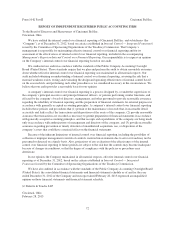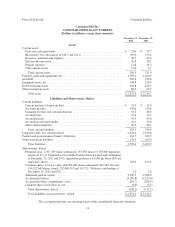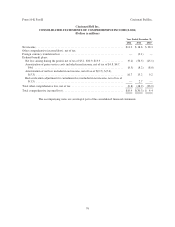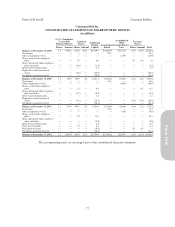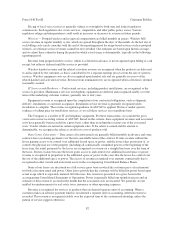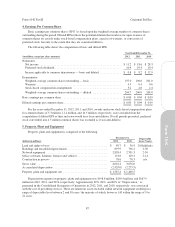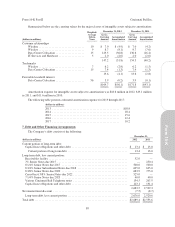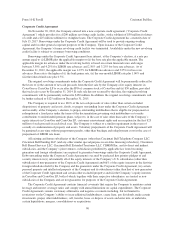Cincinnati Bell 2012 Annual Report Download - page 155
Download and view the complete annual report
Please find page 155 of the 2012 Cincinnati Bell annual report below. You can navigate through the pages in the report by either clicking on the pages listed below, or by using the keyword search tool below to find specific information within the annual report.
Form 10-K Part II Cincinnati Bell Inc.
its eventual disposition is less than its carrying amount. An impairment loss is measured as the amount by which
the asset’s carrying value exceeds its estimated fair value. Long-lived intangible assets are amortized based on
the estimated economic value generated by the asset in future years.
Cost Method Investments — Certain of our cost method investments do not have readily determinable fair
values. The carrying value of these investments was $2.7 million and $2.9 million as of December 31, 2012 and
2011, respectively, and was included in “Other noncurrent assets” in the Consolidated Balance Sheets.
Investments are reviewed annually for impairment, or sooner if changes in circumstances indicate the carrying
value may not be recoverable. If the carrying value of the investment exceeds its estimated fair value and the
decline in value is determined to be other-than-temporary, an impairment loss is recognized for the difference.
The Company estimates fair value using external information and discounted cash flow analysis.
Leases — Certain property and equipment are leased. At lease inception, the lease terms are assessed to
determine if the transaction should be classified as a capital or operating lease. Several of the buildings used in
our former data center operations were leased facilities. When we were involved in the construction of structural
improvements to the leased property, we were deemed the accounting owner of leased real estate. In these
instances, we bore substantially all the construction period risk, such as managing or funding construction. These
transactions generally did not qualify for sale-leaseback accounting due to our continued involvement in these
data center operations.
At inception, the fair value of the real estate, which generally consisted of a building shell, and our
associated obligation was recorded as construction in progress. As construction progressed, the value of the asset
and obligation was increased by the fair value of the structural improvements. When construction was completed,
the asset was placed in service and depreciation commenced. Leased real estate was depreciated to the lesser of
(i) its estimated fair value at the end of the term or (ii) the expected amount of the unamortized obligation at the
end of the term.
Treasury Shares — The repurchase of common shares is recorded at purchase cost as treasury shares. Our
policy is to retire, either formally or constructively, treasury shares that management anticipates will not be
reissued. Upon retirement, the purchase cost of the treasury shares that exceeds par value is recorded as a
reduction to “Additional paid-in capital” in the Consolidated Balance Sheets.
Revenue Recognition — We apply the revenue recognition principles described in Financial Accounting
Standards Board (“FASB”) Accounting Standards Codification Topic (“ASC”) 605, “Revenue Recognition.”
Under ASC 605, revenue is recognized when there is persuasive evidence of a sale arrangement, delivery has
occurred or services have been rendered, the sales price is fixed or determinable, and collectibility is reasonably
assured.
With respect to arrangements with multiple deliverables, management determines whether more than one
unit of accounting exists in an arrangement. To the extent that the deliverables are separable into multiple units
of accounting, total consideration is allocated to the individual units of accounting based on their relative fair
value, determined by the price of each deliverable when it is regularly sold on a stand-alone basis. Revenue is
recognized for each unit of accounting as delivered, or as service is performed, depending on the nature of the
deliverable comprising the unit of accounting.
Wireline — Revenues from local telephone, special access, and internet product services, which are billed
monthly prior to performance of service, are not recognized upon billing or cash receipt but rather are deferred
until the service is provided. Long distance and switched access are billed monthly in arrears. Wireline bills
service revenue in regular monthly cycles, which are spread throughout the days of the month. As the last day of
each billing cycle rarely coincides with the end of the reporting period for usage-based services such as long
distance and switched access, we must estimate service revenues earned but not yet billed. These estimates are
based upon historical usage, and we adjust these estimates during the period in which actual usage is
determinable, typically in the following reporting period.
Initial billings for Wireline service connection and activation are deferred and amortized into revenue on a
straight-line basis over the average customer life. The associated connection and activation costs, to the extent of
the upfront fees, are also deferred and amortized on a straight-line basis over the average customer life.
81
Form 10-K



